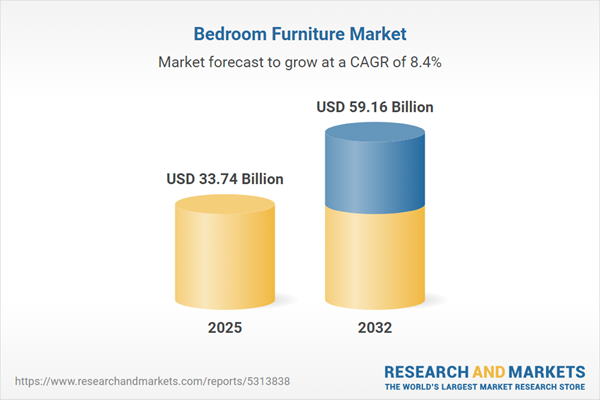Speak directly to the analyst to clarify any post sales queries you may have.
The bedroom furniture market is entering a period of rapid change, influenced by rising sustainability priorities, digital innovation, and shifting regulatory landscapes. Senior decision-makers require actionable insights to guide procurement, sourcing, and strategic planning amidst evolving industry demands.
Market Snapshot: Bedroom Furniture Market Size and Growth Outlook
The global bedroom furniture market is projected to reach USD 59.16 billion by 2032, growing from USD 31.07 billion in 2024 at a compound annual growth rate (CAGR) of 8.38%. Growth is driven by strong demand for modular product offerings, a sector-wide commitment to responsible material sourcing, and continuous advancements in production technology. Companies are leveraging innovation to appeal to both residential and commercial segments. The rise in digital procurement enables organizations to streamline operations, adjust supply strategies, and respond more effectively to competitive pressures and new compliance regulations as buyer needs evolve worldwide.
Scope & Segmentation Analysis: Strategic Insights for B2B Buyers
Clear market segmentation arms executive leaders with the information needed to respond decisively to technology, supply, and demand shifts. Understanding the unique value of each segment supports targeted investments, helps mitigate risk, and highlights the roles that various buyer groups play in shaping market direction. Regional market differences and technology adoption rates present further opportunities for strategic adjustment.
- Product Types: Adjustable beds, memory foam and hybrid mattresses, headboards, dressers, nightstands, wardrobes, specialty frames—supporting flexibility for both hospitality solutions and residential projects.
- Material Types: Hardwood, softwood, aluminum, steel, iron, technical plastics, and glass—offering procurement versatility and supporting sustainability objectives and brand enhancement.
- Style Categories: Contemporary, Scandinavian, rustic, antique, ornate, transitional—enabling organizations to appeal to established and emerging consumer aesthetics across multiple markets.
- Distribution Channels: Department stores, specialty retailers, e-commerce, direct-to-consumer, and home improvement centers—supporting scalable logistics, differentiated marketing tactics, and diverse fulfillment strategies.
- End Users: Space-conscious residential clients seeking customizable solutions, and commercial buyers prioritizing adaptability and modular designs for hospitality portfolios or multi-unit projects.
- Regional Coverage: North America, Latin America, Europe, Asia-Pacific, Middle East, and Africa—each region presenting unique regulatory, supply chain, and digital adoption challenges that shape local compliance strategies and market entry approaches.
- Key Companies Analyzed: Ashley Industries, Bassett Furniture, IKEA Systems B.V., Vanguard Furniture, Home Depot, Copeland Furniture—demonstrating industry resilience and innovation in meeting new sector demands.
Key Takeaways: Strategic Direction for Senior Executives
- The integration of smart technology into bedroom furnishings increases day-to-day operational value and meets the expectations of digitally enabled environments sought by both residential and institutional clients.
- Sustainable and circular sourcing practices foster deeper supplier partnerships, support environmental goals, and reinforce the transparency sought by business partners and end clients.
- The implementation of digital procurement platforms and customer engagement solutions enhances the monitoring of global supply chains, improving regulatory responsiveness and logistical control.
- Advanced inventory classification and analytics empower organizations to respond to consumer preference shifts, maintaining a competitive edge across diverse sales and distribution channels.
- Coordinated IT, manufacturing, and distribution systems enable rapid adjustments to new supply dynamics, helping teams mitigate risks from project changes and supply interruptions.
- The greater use of recycled and engineered materials supports ongoing cost management, sustainability, and supply chain stability in a changing marketplace.
Tariff Impact: United States 2025 Tariffs and Strategic Market Response
Impending US tariff changes are prompting companies to reevaluate sourcing and supplier networks. Many organizations are considering nearshoring, automation, and improved scenario planning to adapt to adjusted cost structures and sustain compliance in an uncertain trade environment.
Methodology & Data Sources
The market research leverages proprietary market data, global trade records, executive-level surveys, and interviews with industry leaders. The analysis also incorporates regulatory filings and patent records, providing a complete perspective on innovation and technology adoption trends in the bedroom furniture industry.
Why This Report Matters: B2B Strategic Advantages
- Comprehensive segmentation and risk clarity allow senior leaders to accelerate procurement and manage supply chain shifts with confidence.
- Systematic evaluation of supply networks and distribution structures supports well-informed compliance strategies and market expansion decisions.
- Actionable, executive-focused guidance empowers leadership teams to proactively address sector shifts, sustainability targets, and competitive positioning.
Conclusion
Senior executives gain in-depth strategies to drive sustainability initiatives, optimize supply chain efficiency, and secure market advantage as the bedroom furniture industry continues to evolve.
Additional Product Information:
- Purchase of this report includes 1 year online access with quarterly updates.
- This report can be updated on request. Please contact our Customer Experience team using the Ask a Question widget on our website.
Table of Contents
3. Executive Summary
4. Market Overview
7. Cumulative Impact of Artificial Intelligence 2025
Companies Mentioned
The companies profiled in this Bedroom Furniture market report include:- Ashley Industries, Inc.
- Bassett Furniture Industries
- BOVA Contemporary Furniture
- Century Furniture LLC
- Copeland Furniture, Inc.
- Craftmaster Furniture Inc.
- Godrej & Boyce Manufacturing Company Limited
- Home Depot, Inc.
- IKEA Systems B.V.
- INTERIO International Limited
- Quality Woods Furniture
- Vanguard Furniture Company
Table Information
| Report Attribute | Details |
|---|---|
| No. of Pages | 187 |
| Published | November 2025 |
| Forecast Period | 2025 - 2032 |
| Estimated Market Value ( USD | $ 33.74 Billion |
| Forecasted Market Value ( USD | $ 59.16 Billion |
| Compound Annual Growth Rate | 8.3% |
| Regions Covered | Global |
| No. of Companies Mentioned | 13 |









